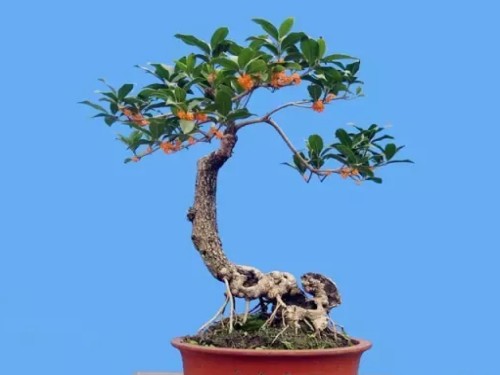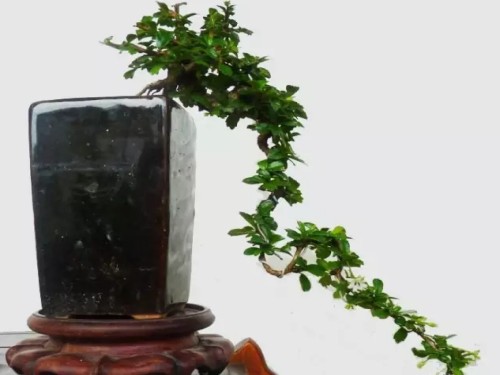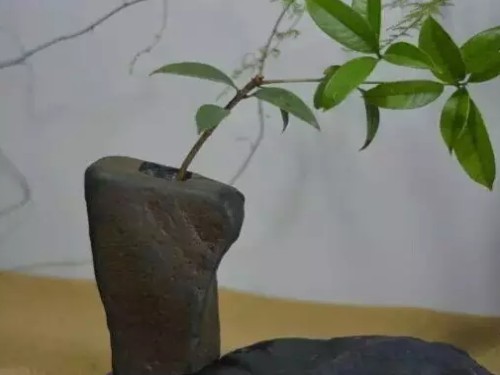How to make osmanthus bonsai
Sweet-scented osmanthus is a good tree species for processing bonsai because of its luxuriant branches, evergreen seasons, intertwined roots, beautiful posture, gorgeous flowers and fruits, fragrant flowers, strong sprouting, pruning resistance, long life and other biological characteristics. The production process of sweet-scented osmanthus bonsai is complicated, learning from nature and wonderful. High-level bonsai benefits from the profound artistic conception and skilled techniques of bonsai teachers.
I. principles of production
Far-reaching composition; learn from natural reality; enhance strengths and avoid weaknesses; dynamic and static combination of dexterity; unified coordination and eye-pleasing; small and medium-sized perception; proper density; clear primary and secondary eye-catching.
II. Variety selection
For small bonsai, it is appropriate to choose "Dongxianghong", "Dongxiang Silver Pavilion", "Japanese Cinnamon", "Big Leaf Buddha Top Pearl", "Laurel", "four Seasons Cinnamon", "Jiulong Cinnamon", "Willow Leaf Cinnamon" and so on. For medium-sized bonsai, it is appropriate to choose "Big Flower Cinnamon", "seed Cinnamon", "Cinnamon Cinnamon", "Big Flower Golden Cinnamon", "Round petal Golden Cinnamon" and so on. The production of large-scale bonsai should choose "big leaf yellow silver cinnamon", "golden cinnamon", "big leaf cinnamon", "Dadan golden cinnamon", "orange red cinnamon".
III. Material selection and cultivation
1. Artificial propagation: sweet-scented osmanthus can be propagated by sowing, cutting, grafting, striping and other methods. Cutting and grafting are usually the main methods, while sowing methods are seldom used.
The cuttage method uses the softwood cuttings grown in the same year in the plum rain season, and the survival rate is high. Cuttings should be cut from 10-year-old sweet-scented osmanthus with a length of 8 cm to 10 cm and a thickness of 0.3 cm to 0.5 cm, with top tips removed and 2 leaves retained. Soak in naphthalene acetic acid 100ppm solution for several hours before insertion, insert it into the tile basin or seedling bed of sandy loam, the depth of 1B2~2B3, should not be too deep, too deep will lead to poor ventilation and easy to rot roots. After insertion, use your fingers to compact the soil, water through, and timely shade, maintain a certain humidity, often spray foliar water, soil moisture should not be too much. After about 60 days, it can take root. After rooting, it can be transparent in the morning and evening, increase the light time after autumn, in order to promote growth, and can be cultivated in pot in the following spring.

2. Sweet-scented osmanthus bonsai grafting is generally used by branch grafting, which includes cutting grafting, splitting grafting and leaning grafting. Lobular privet, wax, privet and other tree species are commonly used as rootstocks. The cutting method is widely used. When grafting, cut the rootstock 5 cm above the ground, choose the smooth side of the bark, cut vertically with xylem and cut into a cut 2 cm to 3 cm deep. The scion takes an annual mature branch, 6 cm long, with 2 cm 3 nodes, and the lower end of the scion is cut into an oblique cutting plane of 2 cm, and then obliquely cut into a short cutting surface of about 1 cm on the opposite side. Then, the long cutting surface of the scion is close to the cutting surface of the rootstock, inserted into the incision, so that the cambium of the two cutting surfaces are closely connected, and then the cortex of the cut of the rootstock is wrapped on the outside of the scion, bound and fixed with plastic film, and the incision of the rootstock and the top of the scion are closed to prevent water evaporation, and it is easy to survive. The support grafting is to cut off the xylem of the female parent branch of the scion and the female parent branch of the rootstock, which is 5 cm in length and 10 cm in length and 1B3~1B2 in dry diameter, then combine them with each other, bind them with plastic film tape, and then separate them after survival. Depending on the survival is very sure, garden nursery cultivation of potted cassia mostly use this method. The strip pressing method is also often used, and it is easy to survive.
IV. The process of potting.
1. Selection of basin
The green leaves and yellow flowers of sweet-scented osmanthus, evergreen all the year round, it is appropriate to choose a deeper round basin or square basin, and the diameter of the basin mouth is roughly the same as that of the branches and leaves of sweet-scented osmanthus, which is beneficial to the development and growth of roots. The texture of the basin is better with purple sand pottery basin or glazed pottery basin. The color is better with purple or ochre, which can be in sharp contrast with the color of flowers and leaves to increase its ornamental effect.
2. Using soil
Sweet-scented osmanthus likes fertilizer, so it is suitable to use sandy loam with loose fertility and good drainage. The culture soil of potted sweet-scented osmanthus is usually made of pastoral soil, barnyard manure and river sand 1B3. Attention should be paid to disinfection so as not to infect diseases and insect pests.
3. Cultivation
Sweet-scented osmanthus should be planted in early spring or autumn. Before putting on the basin, put a layer of river sand or vermiculite on the bottom of the basin to facilitate ventilation and drainage, and then cover it with a layer of peat soil or fine mud about 2-3 cm thick, up to the depth of the basin 1B3. Then, put the sweet-scented osmanthus seedlings with soil balls in the roots into the basin, obstruct the soil to cultivate the soil, press it with your fingers, and fill the soil close to the mouth of the basin. The soil surface should be 2-3 cm lower than the mouth of the basin, so as to facilitate watering and fertilization. After planting, it should be watered thoroughly, then moved to the shade for about 10 days, so that its "basin", gradually restore growth.
5. Pruning methods
Sweet-scented osmanthus has strong germination and resistance to pruning. In 2012, after potting, it was processed and modeled after blooming in Meiyu season or autumn, and the combination of climbing and pruning was adopted. That is, by pruning, cutting, thinning, injuring and other ways to prune the branches to weaken, dwarf and change the tree shape. First of all, the diseased and residual branches, cross branches, overlapping branches, parallel branches and opposite branches are cut off; secondly, the remaining branches are shrunk year by year and node by section strength to gradually form the required tree type.
VI. Orthopedic techniques
1. Processing
Sweet-scented osmanthus has strong germination and resistance to pruning. In 2012, after potting, it was processed and modeled after blooming in Meiyu season or autumn, and the combination of climbing and pruning was adopted. The trunk can be truncated into a curved trunk or oblique trunk; those with a higher trunk can be properly cut to make the base sprout new branches without emptiness in the lower part, or re-cut the upper branches and over-dense branches to stimulate new branches in the lower part of the trunk, maintain the balance between the upper and lower parts, and make the tree beautiful and luxuriant.
2. Tree shape
Sweet-scented osmanthus is best made into curved dry type, oblique dry type or floating style. The tree is oblique, with luxuriant branches and leaves, simple and natural, the most enjoyable. When it blossoms, the fragrance is overflowing and refreshing.
Time: 2019-05-26 Click:
- Prev

Production Technology of Fujian Tea Bonsai
Fujian tea also known as base and tree, cat tree, for Shikoku evergreen shrubs. Leaves small, long oval, dark green and shiny. Spring and summer open white floret, drupe globose, early green after red. It trunk craggy, Qiuqu diversity, tree posture elegant, Lingnan is one of the four major bonsai species
- Next

The method of making stone bonsai
Although the green plant bonsai is embellished, it is so complementary to Yashi, as natural as wild flowers and weeds grow at the foot of the mountain or by the stream, not only without losing nature, but also with elegance and delicacy, and the chaos and disorder without barbaric growth are more pleasing to the eye. Stone bonsai
Related
- Fuxing push coffee new agricultural production and marketing class: lack of small-scale processing plants
- Jujube rice field leisure farm deep ploughing Yilan for five years to create a space for organic food and play
- Nongyu Farm-A trial of organic papaya for brave women with advanced technology
- Four points for attention in the prevention and control of diseases and insect pests of edible fungi
- How to add nutrient solution to Edible Fungi
- Is there any good way to control edible fungus mites?
- Open Inoculation Technology of Edible Fungi
- Is there any clever way to use fertilizer for edible fungus in winter?
- What agents are used to kill the pathogens of edible fungi in the mushroom shed?
- Rapid drying of Edible Fungi

